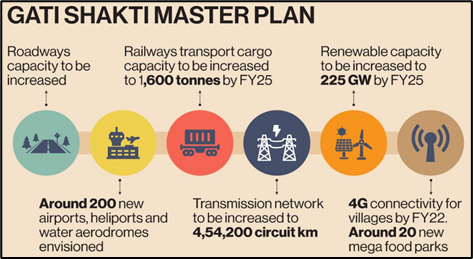In News:
- The Commerce and Industry Ministry's Department for Promotion of Industry and Internal Trade (DPIIT) has begun working with five social sector departments, to improve the efficiency of social sector infrastructure with the help of PM Gati Shakti initiative.
- The social sector departments include the Ministry of Women and Child Development and the Department of Rural Development among others.
What’s in today’s article:
- About PM GatiShakti
- News Summary
PM Gati Shakti - National Master Plan for Multi-modal Connectivity:
- About:
- It is a master plan for multi-modal connectivity (launched in October 2021), to give more speed (Gati) and power (Shakti) to infrastructure projects by connecting 16 Ministries, including Railways and Roadways, on one digital platform.
- While the Government has not specified the size of the programme in financial terms, it will subsume the Rs 110 lakh crore National Infrastructure Pipeline (launched in 2019).

- Six pillars of PM GatiShakti:
- Comprehensiveness: It will include all the existing and planned initiatives of various ministries and departments with one centralised portal.
- For example, it will incorporate the infrastructure schemes of various Ministries and State Governments like Bharatmala, Sagarmala, UDAN etc.
- It will also cover economic zones like textile clusters, electronic parks, etc.
- Prioritisation: It will enable different departments to prioritise their projects through cross-sectoral interactions.
- Optimisation: It will assist different ministries in planning for projects after the identification of critical gaps. For example, for the transportation of goods the plan will help in selecting the most optimum route in terms of time and cost.
- Synchronisation: It will help in synchronising the activities (different layers of governance) of each department in a holistic manner by ensuring coordination of work between them.
- Analytical: It will provide the entire data at one place with GIS-based spatial planning, enabling better visibility to the executing agency.
- For this, spatial planning tools with ISRO imagery developed by BiSAG-N (Bhaskaracharya National Institute for Space Applications and Geoinformatics) will be leveraged.
- Dynamic: All ministries and departments will now be able to visualise, review and monitor the progress of cross-sectoral projects.
- Significance:
- Integrated planning and coordinated implementation.
- Institutionalising holistic planning for stakeholders.
- Integrated and seamless connectivity.
- Better feedback and review mechanism: The GIS platform will give on-ground progress of the projects.
- Easy planning and execution of projects.
- Improves Ease of Living as well as Ease of Doing Business.
- Boosting the Indian economy: Reducing logistics costs → strengthening supply chains → boost the global competitiveness of local products → help India become an attractive investment destination.
News Summary:
- Gati Shakti - National Master Plan, launched last year to reduce logistic costs, is a technology-based tool for effective and integrated infrastructure development in the country.
- Under the PM Gati Shakti plan, all logistics and connectivity infrastructure projects worth more than 500 crore are channelled through the Network Planning Group (NPG).
- Over 250 critical infrastructure projects of different ministries, including rail, road and ports, have been examined and recommended by the NPG since last October 2021.
- Over 1,994 layers of data, including that of land, ports, forests and highways, are available on the portal.
- According to the DPIIT, the PM Gati Shakti program is working well for infrastructure development projects and has just begun collaborating with social sector departments to see how the initiative may be used to enhance the functioning of these sectors.
- For example, apart from building schools and hospitals, the projects could also include transporting children from villages to a larger school, planning anganwadi locations using the data layers through PM Gati Shakti.
- The five departments are health, ministry of women and child development, department of rural development and panchayat raj, education, and ministry of housing and urban affairs.
- Furthermore, it is proposed that the scope be broadened to include the culture ministry in order to strengthen the infrastructure surrounding monuments.










